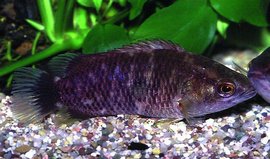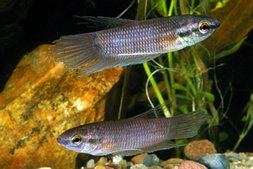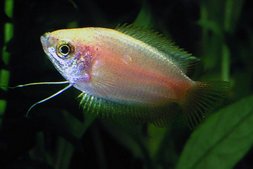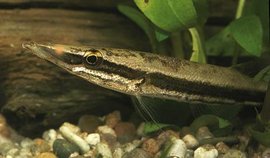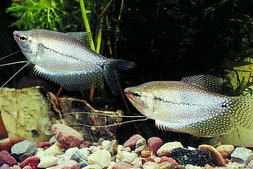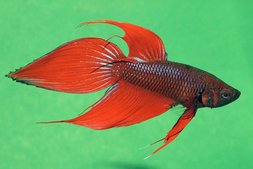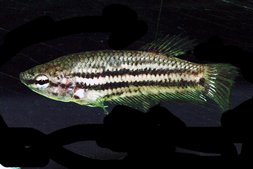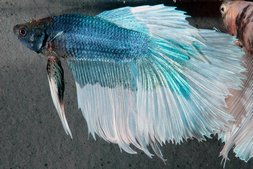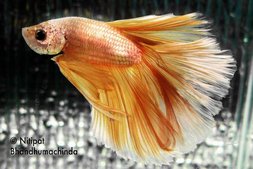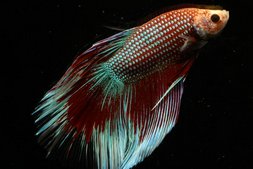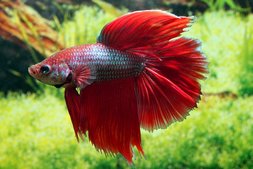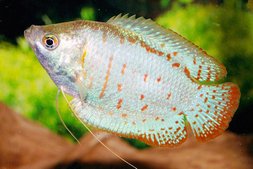Labyrinthfishes
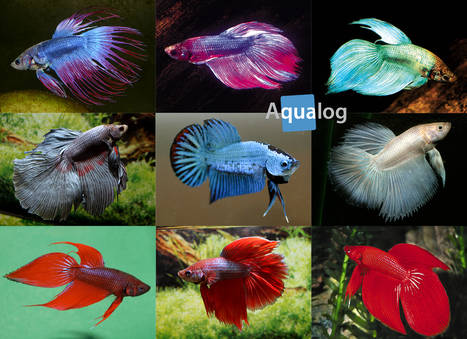
Labyrinthfishes are found in Asia and Africa. A common feature is that they all possess an auxiliary respiratory organ, with whose help they can breathe atmospheric air. The majority of species need to take in air at the surface at regular intervals as otherwise they will drown. In only a few species is the normal method of respiration, via the gills, adequate to supply their oxygen requirement.
The group includes around 160 species in some 20 genera. The majority of species are kept and bred, at least by specialists, as most are splendidly coloured and exhibit a rich and varied repertoire of brood-care behaviour. Some – above all the Siamese Fightingfish (Betta splendens) and the gouramis (Colisa or Trichogaster (the Honey Gourami and its congeners) and Trichogaster or Trichopodus (the Moonlight Gourami and congeners) – there is a dispute over which names are correct for the two genera involved) – are among the most popular ornamental fishes worldwide, and numerous cultivated forms exist. Another labyrinthfish, the Paradisefish (Macropodus opercularis), was the first exotic ornamental fish to reach Europe after the Goldfish.
Zoologically speaking the Labyrinthfishes are not a homogenous group, but composed of the true labyrinthfishes (family Osphronemidae), the climbing perches (family Anabantidae), and the kissing gouramis (Helostomatidae). The snakeheads (Channidae) are sometimes also included in the labyrinthfishes, but are not discussed here.
Maximum length is very variable and species-specific, and the range extends from 1.5 cm (Parasphaerichthys lineatus) to more than 60 cm (Osphronemus). The vast majority of species grow to between 4 and 15 cm long.
Important requirements
The majority of labyrinthfishes live in slow-flowing or standing waters, usually with a rich growth of aquatic plants. The chemical composition of the water is relatively unimportant in most cases; in the wild the water is usually soft (less than 10 °dGH) and neutral to slightly acid or slightly alkaline (pH between 6 and 8). Labyrinthfishes usually inhabit relatively shallow waters that become very warm in the Tropics. Hence the majority of species do best at temperatures between 24 and 28°C.
The blackwater species have special requirements as regards water chemistry. These species, namely the liquorice gouramis (Parosphromenus), chocolate gouramis (Sphaerichthys) and some dwarf fighting-fishes (Betta brownorum and related species (the so-called “small red fighting-fishes”)) as well as Betta macrostoma and the pikeheads (Luciocephalus), live in water with an extremely low pH (around 4) in the wild. This means that the bacterial population there is very low, and these fishes are extremely sensitive to water with a heavy bacterial burden.
For these reasons you must either maintain these fishes in comparable water conditions (i.e. a pH between 4 and 5, which in practice can be achieved only with very soft water) or fit a powerful UV steriliser to the aquarium. The species in question should also be kept somewhat cooler, 20-26 °C is appropriate.
In all species the water temperature should be raised by 2-4 °C for breeding. A slight temperature variation between day and night of around 2-4 °C will correspond to conditions in the wild and is very beneficial to the health of the fishes.
In winter in particular the special breathing method of these fishes needs to be taken into account. They can become chilled in uncovered aquaria where the air they breathe is cooler than the water temperature. For this reason, and because labyrinthfishes are accomplished jumpers, their aquarium should always be tightly covered.
The South African kurpers (Sandelia), which are hardly ever maintained in the aquarium, need to be kept at lower temperatures (16-22°C).
Appropriate feeding
The majority of labyrinthfishes feed on small organisms, and can very readily fed using the usual proprietary fish foods (dry, frozen, and live). Exceptions are the giant gouramis (Osphronemus), which are largely herbivorous and require additional vegetable food; the pikeheads (Luciocephalus), which are trophic specialists that feed only on live shrimps and small fishes; the kissing gouramis, which are plankton feeders and need to be fed on special powdered foods; and the liquorice gouramis (Parosphromenus), which are fed primarily on live Artemia nauplii in the aquarium hobby, a diet that has proved adequate as the sole food offered.
Correct maintenance
In the wild almost all the species commonly maintained in the aquarium occur in water that is sometimes heavily polluted organically. For this reason many labyrinthfishes are regarded as very low-maintenance fish species, in which the usual partial water changes can be reduced to a minimum (10-15% of tank volume every 14 days for a moderate population density). The exceptions are the blackwater species mentioned earlier, where you should aim at regular large water changes: ideally 1/3 – 2/3 of the water should be changed every week, refilling with conditioned, fresh water of the same chemistry; at the same time the difference in temperature between the new water and the aquarium water should be as small as possible and never more than 2-3 °C.
In line with the natural habitat, all labyrinthfishes should always have access to secondary plant material. Dead leaves (of Sea Almond, Beech, Oak, or Walnut), Alder cones, or peat can be utilised, or special liquid preparations added at every water change.
Aquarium and tankmates
Labyrinthfishes are slow-moving fishes that don’t require a large amount of swimming space. For maintenance the bottom area of the tank should be about 8 times body length by 4 times body length. i.e.
80 x 40 cm (length X breadth) for a species 10 cm in length. The aquarium depth is unimportant and can be between 15 and 60 cm; even more for giant gouramis (Osphronemus).
Outside the breeding season labyrinthfishes are usually peaceful, but individual exceptions may occur, for example among the paradisefishes (Macropodus spp.), Ceylon Combtails (Belontia signata), and Three-Spot Gouramis (Trichogaster trichopterus = Trichopodus trichopterus). Male Siamese Fighters (Betta splendens) can be very combative among themselves, as the domesticated form has been bred selectively for fights on which bets are placed. It is often necessary to keep males of this species singly, though they are peaceful towards other species (with the exception of long-finned Guppies). Young giant gouramis (Osphronemus) are intolerant of one another (but not towards other species), while adult specimens are relatively peaceful among themselves.
All labyrinthfishes like densely planted aquaria with a low to moderate current and muted lighting (floating plants!). There are species that practise brood care and others that don’t. The former fall into two main groups: bubblenesters, in which the male builds a nest of air bubbles, usually at the surface, where he guards the eggs; and mouthbrooders, where the eggs and young are brooded in the mouth of the male. When in the mood to breed the males of the bubblenest-building species (Macropodus, Colisa = Trichogaster, Trichogaster = Trichopodus, Pseudosphromenus, many Betta species, Belontia, Malpulutta, Microctenopoma, Osphronemus) guard the nest area, sometimes energetically. At this time the other fishes, including the female, sometimes have to be removed to another aquarium. The mouthbrooding species (Sphaerichthys, Luciocephalus, many Betta species) and the species that don’t practise brood care (Anabas, Ctenopoma, Helostoma) are peaceful towards conspecifics and other species all of the time.
Labyrinthfishes can be kept singly, in pairs, or in mixed or single-sex groups, depending on the degree of interest of the aquarist; it is all the same to the fishes.
Life expectancy
The majority of species show the first signs of age after three to five years of life. It is probable that none of the species lives longer than a year in the wild. Exceptions are the giant gouramis (Osphronemus), which can live for several decades, and the bushfishes (Ctenopoma), which often live for 10 years or more.
Size
All Labyrinthfishes grow very rapidly initially and are usually sexually mature after around six months. Some subtropical species (Macropodus) slow their metabolic rate in winter and hence grow more slowly, and the giant gouramis (Osphronemus) don’t become sexually mature until the age of 16 months. The species usually seen in the aquarium are full-grown at the age of 8-12 months and grow very little thereafter.
Special details
Because of their splendid colours and interesting behaviour, there are a number of international aquarist organisations devoted to labyrinthfishes. Although only around 20 species are usually encountered regularly in the aquarium trade, because all the species known to science have already been successfully bred in the aquarium, it is theoretically possible for rarities to turn up in the trade at some time or other. So please check the label on the sales aquarium for details of the scientific name, expected eventual size, and the temperature and water requirements of the species.





